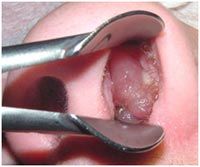Nasal polyps


Nasal polyps
Nasal polyps
Nasal polyps are benign tumours frequently found in the nostrils. They are round, soft and translucent.
They are non-cancerous growths of the nasal lining and can develop at any age.
The cause of nasal polyps is unknown. They are sometimes linked to other conditions such as asthma or sinusitis, and frequently to Aspirin Exacerbated Respiratory Disease (AERD) (characterised by asthma, intolerance to aspirin and nasal polyps).
What are the symptoms?
- nasal obstruction
- nasal stuffiness
- reduced or lack of sense of smell and taste
- in some cases, headaches
- constant nasal congestion without or without a runny nose
How are they diagnosed?
Nasal polyps are diagnosed by a fibrolaryngoscopy. This is a quick and straightforward test that will allow the specialist to see the polyps clearly and can be performed at our surgery The polyps are pale and translucent masses on each side of the nose. If we can see a yellowish mucous-filled discharge, this is a sign of infection.
A CAT scan will allow us to see the exact location and extent of the polyps.
What are the objectives of the treatment?
Polyps vary in their severity. Mild cases can be treated just with medication, either with topical cortisone or, in more severe cases, cortisone administered orally or via an injection. Only a low dose of cortisone is used as although it can improve the patient’s breathing and sense of smell, in higher doses it can have serious side effects.
When medication does not work, treatment will require surgery. Under general anaesthetic, a nasal endoscopy will be performed to remove the polyps. The operation will usually last a couple of hours and a good result will largely depend on the surgeon’s level of expertise.
An endoscopy and microdebrider are used in combination with each other. A microdebrider is a device that separates the polyps from the healthy tissue and removes them using suction, as opposed to stretching (like in surgery), which allows for a much quicker, cleaner and effective procedure, with minimal bleeding. After this procedure, the patient will usually be released from hospital within a maximum of 24 hours.
 by Develona
by Develona